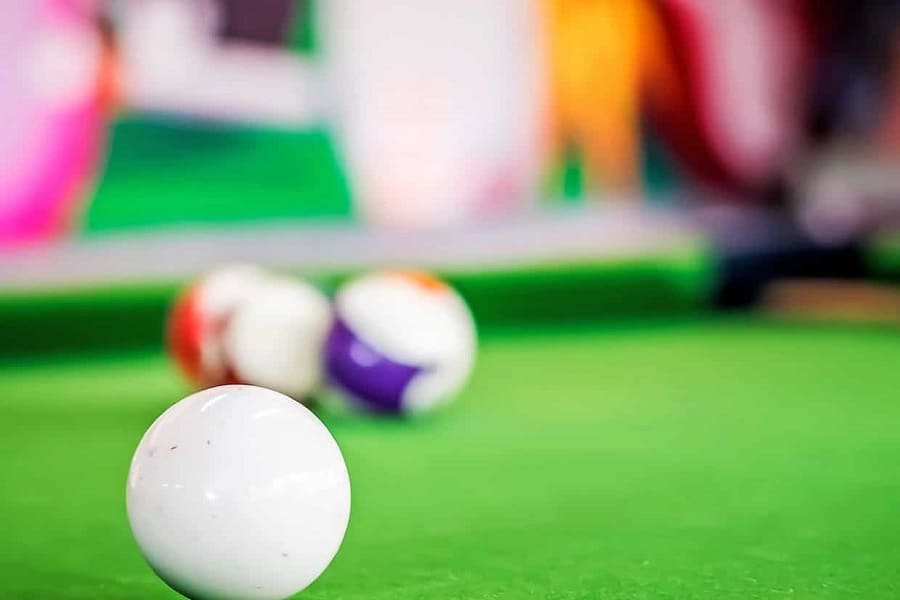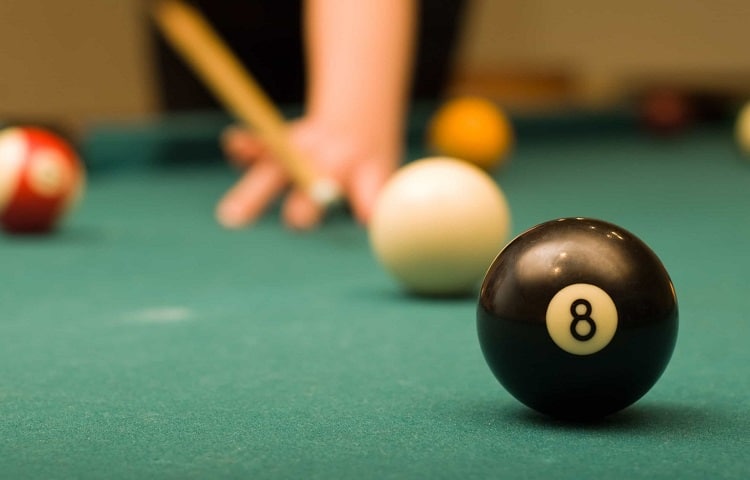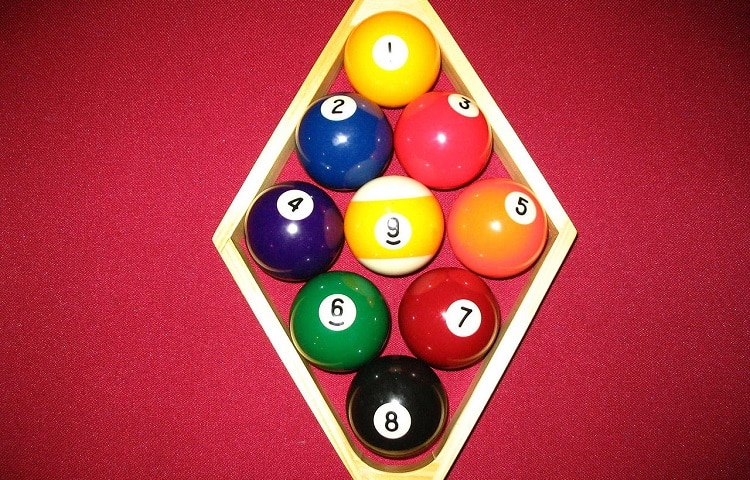 We’ve all been there.
We’ve all been there.
You’re about to pocket a ball and disaster strikes.
The cue ball takes a bad bounce and veers off course, heading straight for a pocket.
Congratulations, you’ve just scratched.
That’s a foul and you will suffer a penalty. Specifically, you lose your turn and your opponent places the cue ball back on the table.
But where exactly do you place the cue ball after a scratch?
The answer, unfortunately, is that it depends.
Keep reading to learn all about the various possible scenarios and where to put the cue ball after a scratch in each one.
Table of Contents
Where To Place Cue Ball After Scratch
Before we get into where you should place the cue ball after a scratch, we thought it would be a good idea to define exactly what constitutes a scratch, because we’ve seen some pretty strange definitions of it.

Definition Of A Scratch In Pool
In simple terms, the term scratch in pool refers to a situation in which you hit a ball or pocket a ball in a way that is counter to the rules of the game.
That definition obviously encompasses quite a few different scenarios, so let’s take a look at the four main types of scratches in more detail.
Break Scratch
A break scratch occurs if you pocket the cue ball while breaking, or if the cue ball flies off the table. You scratch regardless of whether you pocket an object ball alongside the cue ball or not.
Only the cue ball is returned to the table, leaving any pocketed object balls in the pocket. Where the cue ball goes depend on the rules of your particular game. We will cover this below.
Gameplay Scratch
Similar to a break scratch, a scratch during gameplay occurs when you pocket the cue ball with your pool cue, or send it flying off the table.
Table Scratch
What is a table scratch in pool? A table scratch occurs when you miss all of your object balls with the cue ball, or when an object ball does not touch a rail or go into a pocket.
In other words, the cue ball needs to make contact with at least one of your object balls and the object ball must either go into a pocket or touch a rail. If you hit one of your opponent’s balls before hitting one of yours, that is also a table scratch.
8-Ball Scratch
In a game of 8-ball, you scratch if you sink the cue ball while trying to pocket the 8-ball. If you end up pocketing the 8-ball along with the cue ball, you lose the game immediately. The same is true if you send the 8-ball off the table.
If you pocket the 8-ball on break, you automatically win the game. However, if you pocket the cue ball as well (or send it off the table), you lose instead.
What Happens When You Scratch In Pool

When you scratch in pool, you forfeit your turn and your opponent gets to place the cue ball back on the billiard table. Where they can place the cue ball depends on the rules under which you are playing.
If you are playing in a bar or pool hall, it is likely that you are playing under bar rules. Bar rules state that your opponent must place the cue ball in the kitchen. This means they have to put it somewhere behind the head string.
In some cases, this can actually put your opponent at a huge disadvantage. If there is no good shot from the kitchen, they will also likely end up scratching.
Due to this, players will sometimes scratch on purpose to get out of a tricky situation, if they know it will put their opponent in a difficult situation, too.
This is legal, but could also be seen as cheating in a way. In order to counter this, the rules in use at tournaments usually allow your opponent to have a “ball-in-hand” when you scratch.
This means they can place the cue ball anywhere on the table. Obviously, this is a huge advantage for them and a huge incentive for you to not scratch.
Whenever you play a game of pool, you should always clarify before the game begins what set of rules you will be using. It is important to agree beforehand on what will happen if a scratch occurs.
Best Spots To Place The Cue Ball
The perfect spot to place your cue ball for any shot, whether it’s stunning or rolling, is on either side of an imaginary line going through the object balls (OB).
This will give you more control over where the cue ball (CB) goes after impact.
You can also use Dr. Dave’s peace-sign technique for hard shots when you have to aim with just one hand. Point your fingers up if you need to hit left and down if you need to hit right.
Overall, the best spots on the table are those where there is an opening directly in front of and behind (or above) the ball.
These areas allow you more options during your turn, because you have room to either draw back from contact or hit forward into them, without moving off-center too much just yet.
Both provide different types of action, depending on what angle you need most at this point, given how close your opponent’s balls may be situated.
Difference Between 8-Ball And 9-Ball
8-Ball and 9-Ball are the two most popular and commonly played games. The two types of pool games are quite different, but when it comes to scratching, the rules are basically the same.
That’s really all you need to know for the purposes of this article, but we feel it makes sense at this point to briefly sum up the main differences in these two popular billiard games.
The primary difference between the two games is that you and your opponent are gunning for different balls in 8-Ball, while you gun for the same ones in 9-Ball.
In 8-Ball, there are 15 balls in total with different colors and numbers: 7 solid balls, 7 striped balls, and the 8 ball. Whoever is first to sink a ball determines their “side”. For example, if you sink a striped ball first, then you are now shooting for stripes.
It is now your goal to sink all of the striped balls on the table. Once you have done that, you can move on to the 8-ball. The first player to sink the 8-ball (without scratching) wins the game.
In 9-Ball, you only use 9 balls, numbered from 1 to 9. They are arranged in a diamond pattern to start the game, not in the familiar triangle pattern of 8-Ball.

You want to sink the balls on the table in numerical order, beginning with the 1 and ending with the 9. If you miss, your opponent takes over and picks up where you left off.
Say you pocket the 1 and 2-balls, then miss your next shot. You opponent now continues with the 3-ball. You continue pocketing in order, until you reach the 9-ball.
Whoever pockets the 9-ball wins the game. It makes no difference how many balls you pocketed before that. In other words, you can pocket every single ball from 1 to 8, but if you miss on the 9-ball and your opponent sinks it on his or her turn, they win the game.
Placing Cue Ball After Scratch: Conclusion
Scratch rules in pool are simple and complicated at the same time. They are simple in that there is always a consistency throughout the game you are playing, but complicated in that different games play under different rules.
And one of the primary ways different rule sets differ is in what happens when someone scratches.
If you scratch, you forfeit your turn and your opponent places the cue ball back on the table. There are usually two options for how they will return the cue ball to the table.
Under some rule sets, they must place the cue ball in the kitchen and take their shot from there. This can lead to some seriously disadvantageous situations for the player who should actually be benefitting from a foul.
For that reason, other sets of rules allow the opponent to take a ball-in-hand. This means they get to place the cue ball anywhere they wish, which is much more of an advantage (and much more of a penalty for committing a foul).
One of the most tips for pool to remember when playing any game of pool is to discuss the rules of the game with your opponent beforehand. That way you avoid any potential for misunderstanding.
Leave a Reply